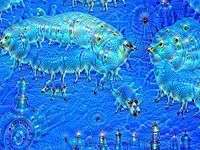DeepDream
.jpg)

.jpg)
DeepDream is a computer vision program created by Google which uses a convolutional neural network to find and enhance patterns in images via algorithmic pareidolia, thus creating a dreamlike hallucinogenic appearance in the deliberately over-processed images.[1][2][3] Google's program popularized the term (deep) "dreaming" to refer to the generation of images that desired activations in a trained deep network, and the term now refers to a collection of related approaches.
Software
The DeepDream software originates in a deep convolutional network codenamed "Inception" after the film of the same name,[1][2][3] was developed for the ImageNet Large-Scale Visual Recognition Challenge (ILSVRC) in 2014[3] and released in July 2015. The software is designed to detect faces and other patterns in images, with the aim of automatically classifying images.[4]
However, once trained, the network can also be run in reverse, being asked to adjust the original image slightly so that a given output neuron (e.g. the one for faces or certain animals) yields a higher confidence score. This can be used for visualizations to understand the emergent structure of the neural network better, and is the basis for the DeepDream concept. However, after enough reiterations, even imagery initially devoid of the sought features will be adjusted enough that a form of pareidolia results, by which psychedelic and surreal images are generated algorithmically. The oft-cited resemblance of the imagery to LSD- and psilocybin-induced hallucinations is suggestive of a functional resemblance between artificial neural networks and particular layers of the visual cortex, a matter which merits further study.[5]
After Google published their techniques and made their code open source,[6] a number of tools in the form of web services, mobile applications, and desktop software appeared on the market to enable users to transform their own photos.[7]
See also
References
- 1 2 Mordvintsev, Alexander; Olah, Christopher; Tyka, Mike (2015). "DeepDream - a code example for visualizing Neural Networks". Google Research. Archived from the original on 2015-07-08.
- 1 2 Mordvintsev, Alexander; Olah, Christopher; Tyka, Mike (2015). "Inceptionism: Going Deeper into Neural Networks". Google Research. Archived from the original on 2015-07-03.
- 1 2 3 Szegedy, Christian; Liu, Wei; Jia, Yangqing; Sermanet, Pierre; Reed, Scott; Anguelov, Dragomir; Erhan, Dumitru; Vanhoucke, Vincent; Rabinovich, Andrew (2014). "Going Deeper with Convolutions". Computing Research Repository. arXiv:1409.4842
 .
. - ↑ Rich McCormick (7 July 2015). "Fear and Loathing in Las Vegas is terrifying through the eyes of a computer". The Verge. Retrieved 2015-07-25.
- ↑ LaFrance, Adrienne. "When Robots Hallucinate". The Atlantic. Retrieved 24 September 2015.
- ↑ deepdream on GitHub
- ↑ Daniel Culpan (2015-07-03). "These Google "Deep Dream" Images Are Weirdly Mesmerising". Wired. Retrieved 2015-07-25.
External links
- Deep Dream, Ipython notebook at GitHub
- Mordvintsev, Alexander; Olah, Christopher; Tyka, Mike (June 17, 2015). "Inceptionism: Going Deeper into Neural Networks". Google.